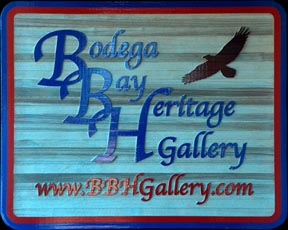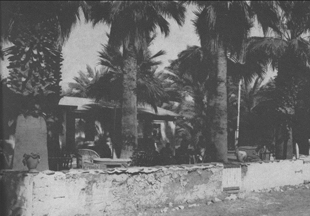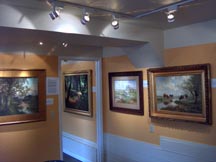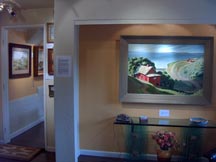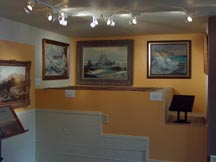Homepage | Contact Us | Our Location
| A-B | C-D | E-G | H-He | Hi-J | K-M | N-P | Q-S | T-Z |
California/American School | Alpha Listings of Artists | Recent Acquisitions
Watercolors | Farm Scenes | Coastal | Deserts | Mountains | National Parks | Still Life & Portraits
|
|
Homepage | Previous issues: July | June | May | April
|
In the August issue:
-SONOMA COUNTY'S OWN GRACE ALLISON GRIFFITH 1885-1955
-JOHN W. HILTON'S OLD HAUNTS TARGETED FOR DEMOLITION; IF ONLY THOSE WALLS COULD TALK
-A WINE COUNTRY EARLY CALIFORNIA ART TOUR
-SPECIAL MUSEUM EXHIBITS RELATING TO EARLY CALIFORNIA ART
-BODEGA BAY HERITAGE GALLERY UPCOMING EXHIBITION SCHEDULE
-SNAPSHOTS OF THE JULY SHOW OF ROBERT RISHELL 1917-1976 AND HUGO ANTON FISHER 1854-1916
|
* * * * *
August Painting of the Month
Grace Myrtle Allison Griffith 1885-1955
Photo of Grace in 1905 at age 20
courtesy of the artist's family |
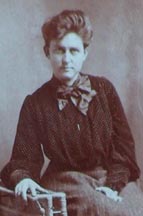 |
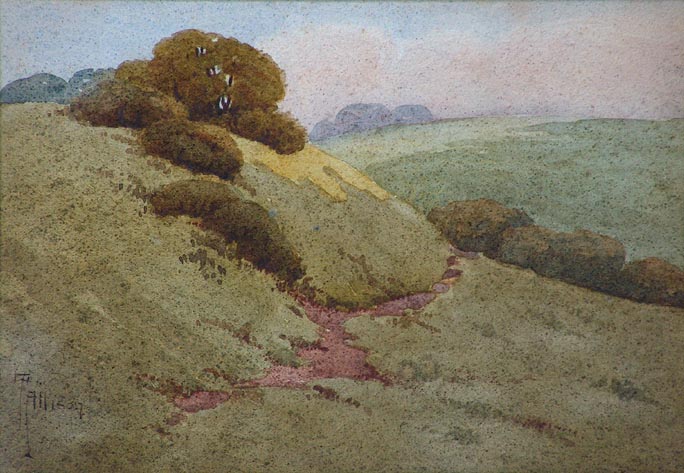
Pasture Path
Watercolor, 5 1/2 x 7 1/2
Sonoma County's Own
Grace Allison Griffith 1885-1955
West Sonoma County is Grace Myrtle Allison Griffith territory. Whereas others may wax enthusiastic about Percy Gray or Lorenzo Palmer Latimer, hereabouts we know the equal quality of Grace's works. Grace was born in 1885. Her family's home was in Vine Hill, near Sebastopol and Santa Rosa, a ranch where she was born and where she returned at the end of her life, to the same house that had been built after the original one was destroyed by fire in 1919. It is up towards the redwoods of the Russian River. The property was graced by a streamside side park of redwood glades created by her father, called "Griffith Woods". This magical place was enhanced even more by the three daughters, Grace, Alice, and Nell. The family and Griffith Woods was written about quite favorably in the 1926 History of Sonoma County volume. We have spoken to people who remember Grace, but they were children then. She died in 1955 at the age of 70 after moving back to the family farm in Sebastopol from Berkeley, where she had lived from 1939 on Virginia Street until her husband Archie O. Harris died in 1950. Relatives describe the delight Archie showed as he accompanied Grace on her painting excursions late in life. Even distant relatives describe her as generously gifting to young people her paintings that they admired.
To hear about Grace is to be reminded about those early times when Northern California communities other than San Francisco and Berkeley/Oakland were their equal in resources and sophistication. The West Sonoma towns such as Valley Ford, Occidental, and Sebastopol had railroad lines and were extensively self sufficient and had major agricultural, lumber, and other thriving enterprises. They had gracious residential areas with fine dwellings, many of which survive today. It is to be reminded that scientific, cultural, and travel opportunities existed more than 100 years ago in a range that may surprise us. |
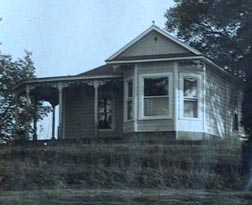
Original Griffith house in Vine Hill
|
Grace's father Nathaniel A. Griffith introduced the Gravenstein apple to the Sebastopol region, earning himself the nickname "Grandfather of the Gravenstein." Grace's father and her pioneering family appear prominently in the recorded history of the region. While perhaps wine grapes are the wave of the future, nevertheless the surviving orchards should be regarded as a source of pride in the past of the region, as well as admired for seasonal beauty. By 1910 the county had 5,700 acres of apples. By 1920 the acreage of apple orchards had increased to 27,000. By 1953, at the height of apple production in the county, the crop's value hit $5,565,000. But in the 1990s vineyards replaced orchards, reducing the county's apple acreage to 4,000 by the end of that decade.
Agricultural science is part of the heritage of the region. Grace assisted Luther Burbank (1849-1926) by making scientific drawings of his plants. Some of these became popular prints. Luther Burbank was a very good friend of the family. Although the well-known Luther Burbank home is in Santa Rosa, his experimental gardens still exist for visitors to see on the near west side of Sebastopol, accessed from the Bodega Hwy.
All three of the daughters were very artistic and achieved much. Grace became a famous painter. Nell (Nell Griffith Wilson) was a poet, who authored books such as "The Heart Remembers," and a world famous poem published by Eleanor Roosevelt, "A Blood Donor's Prayer." Alice Griffith had much to do with Grace's artistic expression and business in Petaluma and Hawaii, but herself was known for her naturalistic endeavors, and particularly the beautiful expression that was Griffith Woods.
Grace began painting while at Cogswell Polytechnic High School in San Francisco. She later studied art in San Francisco with Lorenzo Palmer Latimer. With Alice, she ran an art school and shop in Petaluma during 1912 to 1914. The same two sisters kept an art studio for a couple of years in Hawaii before World War I and again in 1920. When her Hawaii works come available on the market, they are highly sought after. She visited Europe, where her works were exhibited widely, and she became a member of the Royal Watercolor Society of London. She had solo shows in San Francisco, Berkeley, and Los Angeles. She was also a member of the Western Artists of San Francisco and the National League of American Pen Women. Her works were included in many exhibits and publications. These are pretty big achievements whether measured then, or now.
Grace's paintings are distinctively hers - you can spot them from across a room. Her signature is distinctive in execution, even if the name varies. We have paintings signed Allison (the surname of her first husband), signed Harris (the surname of her last husband), signed Griffith, and even Allison Griffith. We have seen some signed Griffith Allison. Her importance has been recognized by inclusion in Section I of "An Encyclopedia Of Women Artists Of The American West" by Phil Kovinick and Marian Yoshiki-Kovinick, 1998.
* * * * *
John W. Hilton’s Old Haunts
Targeted for Demolition;
If Only Those Walls Could Talk
|
In California's "Colorado Desert," just south of Palm Springs and Indio and located on the north shore of the Salton Sea, is the locale of some fascinating chapters in the life of John W. Hilton. From 1938 through 1942, John lived in the ranch house at Rancho Dos Palmas. And, if only those walls could talk, they would have tales to tell.
But Rancho Dos Palmas is now under the care of the Bureau of Land Management, the BLM. They are charged with restoring and preserving habitat for endangered species, a very noble goal.
|
But in furthering their goal, they are considering demolishing the old ranch house and bunk house at Rancho Dos Palmas, citing their poor condition and their so-called lack of historical significance. After all, what does preserving a marginally historical structure once lived in by an artist have to do with restoring and preserving natural habitat?
That’s a fair question. But who is best to answer it? I suggest we listen to the ranch house walls.
Inside those walls, John hosted his painting friends, desert artist compatriots like Jimmy Swinnerton, Maynard Dixon, and Vic Forsythe. They would set up their easels and tell the world through their artistry of the desert’s life and beauty. John learned a great deal from the older members of that painting fraternity, lessons which would support him throughout his artistic life. If only those walls could talk, and tell us of those fireside conversations. Can you imagine sitting in on a conversation scented with tequila and pipe tobacco with Swinnerton, Dixon, Forsythe and Hilton?
If we could transcend time and sit in on one of those talks, I think that these artists, if asked, would support the BLM’s mission of restoration and preservation. They all loved the desert. When Swinnerton first came to the Southwest at the beginning of the twentieth century, most people thought it to be a vast wasteland. He painted its life and beauty to change people’s minds, and created compositions with a full range of color, especially its greenery. Dixon showed its vast tracts of endless land and sky. Forsythe created compositions of balanced and spectacular beauty, and Hilton treated the desert land and sky as if they were alive.
But there’s more. These walls have another fascinating tale to tell. At the outset of World War II, John Hilton learned that General Patton was planning to train tank crews in the Mojave for service in North Africa and Europe. Hilton knew the desert as well as anyone, and he offered his services to some army officers. After a phone call invitation from General Patton, Hilton found himself on a reconnoitering mission rolling through the Mojave and Colorado Deserts in a convoy of several jeeps commanded by Patton himself. On this trek, the artist and the general became friends, and John hosted the general at Rancho Dos Palmas.
As the war began, John learned of a way to serve the war effort without leaving home. Because of his background in the desert’s geology, and near Rancho Dos Palmas, he mined a rare mineral used in making sights for defensive guns of allied bombers to defend against German fighter planes. The mineral was a crystal called optical calcite. John began this enterprise while living at Dos Palmas. He could have gotten wealthy from his mining, but chose not to ask the army for more money. He felt helping out with the war effort was reward enough. John’s calcite mine is the subject of an upcoming book by Larry Hughes.
After the war, John had contact with another notable army general named Eisenhower. Ike was a painter too, and asked Hilton some for artistic advice. Hilton was asked by Ike to attend the inauguration in 1953, and Ike had a Hilton painting hanging in the Oval Office. Later, that painting was displayed in the Eisenhower hospital in Palm Springs.
So, the BLM still wants to demolish the ranch house and bunk house at Rancho Dos Palmas?
Well here is what I hope is a helpful suggestion: why not use the ranch house as a museum and visitor’s center?
Let the walls do the talking. Hang some of the major works of these notable artists who visited there, well lighted and on prominent public display. Let the paintings do what they were originally intended to do, speak to the beauty and glory of this land. In this way, the artists would be supporting what the BLM is all about -- restoration and preservation.
Once a large enough circle of people get enthused about such a project, resources will be found to make it happen.
There could also be an historical display of Hilton and his connection with General Patton and his mining of optical calcite during the war. This display could tie in with other historical exhibits of Patton’s tank training efforts throughout the Mojave. There could also be an exhibit of Hilton’s connection with General Eisenhower, and maybe an Eisenhower painting could be exhibited as well.
There could be well done environmental displays, designed to teach future generations of Americans about the treasure they are inheriting -- the Colorado Desert with all its plants and animal life. Perhaps there could be a minimal zoo too, allowing the public to see some of the desert’s creatures close up.
For now, art lovers might view the BLM’s plan to be a disaster, but perhaps it is a great opportunity to join the BLM and the artists in a common goal.
Here are some links and addresses to learn more and express your thoughts.
the Press Enterprise
http://www.pe.com/localnews/inland/stories/PE_News_Local_C_oasis22.3c06e5d.html
My Desert.com
http://www.mydesert.com/apps/pbcs.dll/article?AID=2007707090303
Desert Magazine, January 1947
http://www.sci.sdsu.edu/salton/DosPalmasHistory.html
the Congressional District served by Rep. Mary Bono
http://bono.house.gov/
Bodega Bay Heritage Gallery’s John Hilton Page
http://www.bbhgallery.com/Hilton_John_W_.htm
* * * * *
A WINE COUNTRY EARLY CALIFORNIA ART TOUR
Horizon Air (related to Alaska Air) has already opened service to Santa Rosa's "Charles M. Schultz Sonoma Co. Airport" from LAX and Seattle. They have announced that in October 2007 they will add a third LAX flight plus new direct service to/from Portland. This is a nice little airport on the North side of Santa Rosa. The car rental agencies are right there in the small terminal. There are no long corridors or escalators. The parking lot is right outside the door. Plus for our "loop" you do not have to venture out onto Hwy 101, but instead can quickly connect to River Road from the Airport. From the airport, take Airport Blvd. straight out and under Hwy 101, and turn right (south) on Fulton Rd. Soon, turn right again on River Rd. and head for the resort towns on the Russian River towards the Coast.
To go directly to Bodega Bay from the airport take Hwy 101 South, exiting on Hwy 12 West which is just after downtown Santa Rosa. Take that into Sebastopol, and continue straight ahead in downtown Sebastopol onto the Bodega Hwy. Right after you pass the separate town of Bodega, you will come to Hwy 1. Turn right towards the Coast. It is about 50 minutes from the airport. A route that skips Hwy 101 and will sometimes be faster is to pass under 101 and turn right on Fulton Rd., taking that south to Hwy 12 and turn right to Sebastopol etc. |
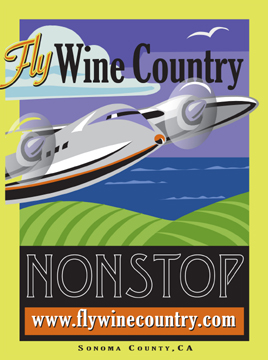 |
The season is arriving when folks in Sonoma County are thinking about the grapes ripening on the vines, and the upcoming harvest season. The vineyard rows are lush; the Russian River and its redwoods beckon; the Pacific Ocean glistens on stretches of beautiful beaches; the farms stretch out over the rolling hills. All is well with the world.
For a handy map, use the one on www.bodegabay.com or another West Sonoma County tourism site. The following is a travel "loop," with many options, that combines scenic beauty with some of the best places to enjoy Early California Art. For convenience we'll describe this tour from an airport start. But you can just as easily start from Petaluma at the South point, or any of the Russian River exits from 101 coming from the North. Assuming that you have started from the North, stay on the north side of the Russian River and travel past those populated areas, through vineyards and redwood groves, to Duncans Mills. Side trip: Before Duncans Mills, take a quick trip South on Hwy 116 to other kinds of art galleries in Forestville and Graton.
Don't just zip by Duncans Mills, but instead turn in to the right to the John Orr's Gardens shops behind the Cape Fear restaurant. At the back building #4 is the two-story Christopher Queen Galleries www.christopherqueengalleries.com and its Early California offerings upstairs. Now until September 30, 2007, they are in addition throughout the gallery presenting the annual "The Quintessential Bohemians" show that features painters who were early members of the Bohemian Club and who participated in the nearby Bohemian Grove encampment. Some very special works are on display. Nearby is the Quercia Gallery, www.querciagallery.com . Ron and Bobbi are preparing a 20th anniversary show of their works for August. We got a sneak peek at Bobbi's new sculptures. We have her sculptures for our home, but this new series is both striking and touching. Besides his distinctive plein air paintings of Bodega Bay, Ron specializes in restoring frames for Early California paintings.
Then proceed out towards the Coast, and turn south on Highway 1 towards Bodega Bay. It is about a half-hour drive from Christopher Queen Galleries. On the north side of Bodega Bay, past the Sonoma State Beach entrance and the memorial Bell Tower, you will arrive at the intersection of Eastshore Rd. with Hwy 1. Just down to the right is the Blue Whale Building. Local Color Gallery (a cooperative of local artists) is at the front of the building www.localcolorgallery.com, and our gallery of Early California Fine Art is at the back of the building, with the driveway to our parking lot at the corner of the Seaweed Cafe. On Hwy 1 just past our intersection is our neighbor gallery The Ren Brown Collection www.renbrown.com (Japanese prints).
Side trip: As you proceed south on Hwy 1 from Bodega Bay, you can take another side trip at the intersection for the town of Bodega. You can go on a side trip north on the "Bodega Hwy", stopping at the Jerry Dodrill photography gallery at the town of Bodega, looking at the schoolhouse from "The Birds", and then proceeding onward for a while, then taking the Bohemian Hwy to the left at the Wildflour brick oven bakery to Occidental, a nice place to visit with romantic lodgings and nice shops.
Alternative or after the side trip above, proceed on Hwy 1 to Valley Ford and enjoy the shops and restaurants there. Afterwards, don't turn right on Hwy 1 towards Tomales, but instead stay straight towards Petaluma. Turn right on Petaluma Blvd. in the historic downtown area, and at the Western Ave. intersection, both at the corner and a few doors up Western, enjoy Early California Art in the context of antique stores The Vintage Bank and also Sean's Antiques. It is about 35 minutes from Bodega Bay to Petaluma.
You can consider other adventures along the way: For example: (a) A nice hike among the redwoods at Armstrong Redwoods park just a short drive north of Guerneville, (b) Canoeing or kayaking in the Russian River or Bodega Bay areas, (c) Goat Rock park's views and sandbar on the South side of the outlet of the Russian River to the ocean, (d) the other Sonoma State Beaches along the Coast to Bodega Bay, (e) whalewatching and a nice walk around Bodega Head (after our gallery).
For details on other kinds of art galleries along the way and as described above, see www.scgg.org or pick up the brochure with map in our gallery. For Early California art galleries beyond this loop, and in other parts of California and elsewhere, consult the comprehensive list on Nancy Moure's site, www.californiaart.com/galleries.html . These include Garzoli Gallery in San Rafael; Northpoint Gallery and Montgomery Gallery in San Francisco; and Lee Youngman Gallery in Calistoga north of Napa (for more Ralph Love paintings). While you are at our gallery in Bodega Bay, visit our neighbors Local Color Gallery and The Ren Brown Collection. For an overview of the whole region, including wineries to visit, see www.sonomacountry.com . For information on coastal activities, restaurants and accomodations, stop at our Visitors Center past the center of town from us, across from The Tides on the edge of Bodega Bay.
* * * * *
SPECIAL MUSEUM EXHIBITS OF EARLY CALIFORNIA ART
Desert Painters (Palm Springs) but check dates
http://www.psmuseum.org/art_current_06_Treasures%20of%20the%20West.shtml
Maynard Dixon (Pasadena) to August 12
http://www.pmcaonline.org/current-exhibitions.html
Yosemite (Oakland) until August 26
http://www.museumca.org/exhibit/exhi_yosemite.html
Edwin Deakin (Sacramento) to April 20, 2008
http://www.crockerartmuseum.org/exhibitions/exhib_pages/Deakin.html
Botke, DeRome, Rider, & Wendt (Irvine) to October 13
http://www.irvinemuseum.org
William F. Ritschel, The Poetry of Waves (Monterey) to December 9
http://www.montereyart.org/exhibitions/current.html
French Impressionists (San Diego) to September 30
http://www.sdmart.org/exhibition-impressionist-giverny.html
Rotating history gallery (Santa Rosa)
http://www.sonomacountymuseum.com/docs/featuredexhibitions.html
* * * * *
Exhibitions at Bodega Bay Heritage Gallery |
August |
|
September |
"Sheep May Safely Graze"
farms and farm animals by famous Early California painters |
October |
|
November |
|
December |
"Small Gems"
magnificent antique still lifes and small landscapes to be treasured |
|
WPA / California Style Watercolors
|
Visit soon and often, and plan to view our special exhibitions. |
